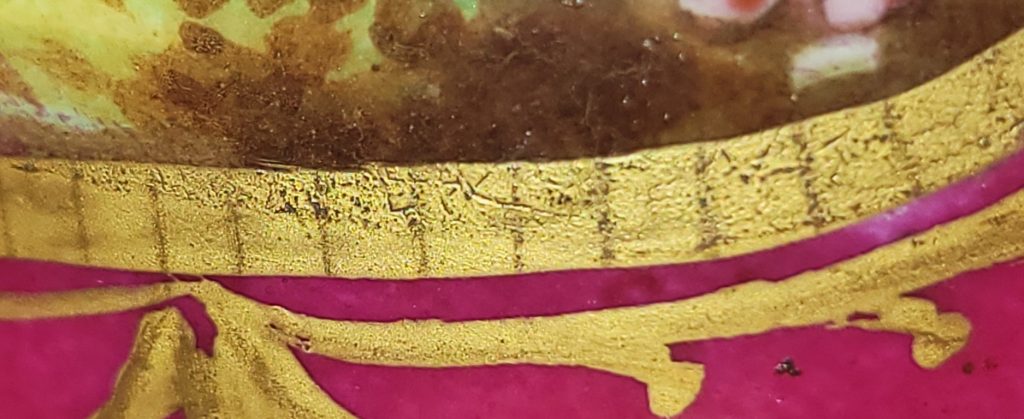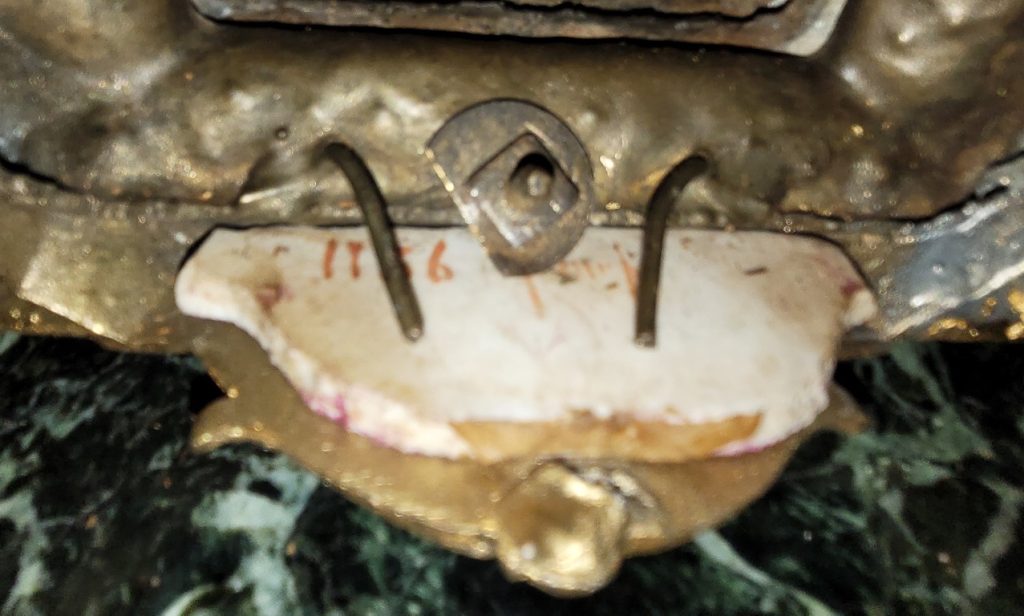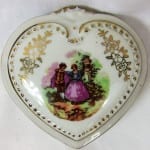French 19C Japy Freres & Red Sevres Porcelain Mantle Clock with Garniture Set
PRESENTING A STUNNING mid to late 19C French Japy Freres & Red/Magenta Sevres Porcelain Mantle Clock with Garniture Candlestick Ewers.
The clock movement is by the famous Parisienne Clockmaker … ‘Japy Freres’ and the clock dial has the marks for “JAY” (short for Japy Freres) & “Paris” on the dial face.
The clock mechanism and clock face/dial have matching serial numbers of “7225”. The movement also has the numbers: “5 – 2”.
The clock face/dial also has the initials: “D.H.”.
The gilt ormolu clock case is gilded spelter and is signed on the rear base, for having been made by “P.H. Mourey” of Paris, who worked with and for, ‘Japy Freres’, towards the end of the 19th Century.
The signature of ‘Mourey’ also bears the numbers “85” … probably for 1885, but this could also be the serial number.
Taking into account Mourey’s historical association with Japy, being late 19th Century, we are leaning heavily towards this being the date of manufacture i.e. 1885.
The Clock has RARE red/magenta Sevres hand-painted porcelain paintings/additions, to include:-
(i) a 2 handled and lidded urn on the crown with pointed flame finial,
(ii) a pair of bulbous urns either side of the main body and clock face,
(iii) the clock face and dial itself and
(iv) a flat rectangular medallion on the front base.
The crown urn and the base medallion both have similar themes, but different painted scenes, depicting French rural countryside scenes with cottages, rivers and bridges.
The porcelain urns on the sides, likewise have hand-painted images of a young boy, in rustic period attire on the right and a young girl on the left.
None of these paintings appear to be signed.
The clock case has GLORIOUS detail to it, with scrolls, ribbons, vines, grapes and Corinthian columns.
The clock sits on a custom made gilt wood and burgundy velvet plinth, that is original to the piece and was a common accent with ‘Japy Freres Clocks’, when originally retailed in their Paris shop.
The rear of the clock is plain and the perspex/clear resin plate insert, is a new addition, but a nice addition, in that it allows one, to view the movement and pendulum works.
The clock is an 8 day movement with a strike on the hour and half hour. The clock face has 2 winding holes … one for the pendulum movement and the other for the striking chime/ring.
Unlike British clocks this clock does not have a long musical chime … it is a simple ‘single strike’ on the half hour.
The red/magenta Sevres porcelain clock face/dial is in SUPERB condition. Roman numerals with gilt accents and a hand-painted circular wreath/bouquet of spring flowers on the center section.
To complete the set, we have a matching pair of gilt ormolu spelter and hand-painted red/magenta Sevres porcelain Ewers … which can hold a single candle each.
The porcelain urns on the central section, have hand-painted images of a young lady in rustic period attire … fishing on the riverbank on the right and a young man playing the flute in the countryside on the left.
The front base medallions on each ewer have hand-painted wreaths/bouquets of spring flowers.
The clock facing side of the porcelain urn on each Ewer, has a brass ormolu applique head, of the Greek god of wine-making, orchards and fruit, vegetation, fertility, festivity, insanity, ritual madness, religious ecstasy, and theatre, namely, Dionysus.
The plinths are signed on the rear top left corner, and we think they read: “R.P. Unfaut”. They also bear the numbers “61” and “69”, Again, possibly for 1861 and 1869, but here we think it is more likely they are serial numbers, as it is highly unlikely that a matching pair were made 8 years apart!
Whilst we cannot find any information on ‘R.P. Unfaut’, we can only guess that he/she/they worked with, or for, ‘Japy Freres’, as these ewers are unmistakably, a ‘superb’ match for the clock!
The style, subject matter, gold banding and edging, around the paintings, are virtually ‘identical’ to the same decorations on the clock’s porcelain paintings.
The Ewer on the left (with the boy playing the flute) appears to have a faded signature on the gold border of the painting towards the base and we think it is the signature of ‘Alexandre Evariste Fragonard’ …. one of the best known artists attached to Sevres in the mid 19th Century … meaning, that these Ewers were probably made circa 1845-50.
The quality and detail to these 2 paintings is classic Fragonard!
We are of the opinion, therefore that these garnitures, were made circa 35/40 years before the clock, as Mourey was prevalent with Japy around 1880 – 1900.
The clock paintings are of a very similar, rustic ‘Fragonard Style’ subject matter and although unsigned, could possibly have been painted by a Sevres artist, to replicate the Fragonard paintings on the earlier Ewers. Whilst very nicely painted they are not of the same exceptional quality of the original Fragonard paintings, when viewed closely in comparison with the Ewers,
The Ewers have floral decorated spouts and handles decorated with vine, floral and grape accents …. again replicating the vine designs on the clock and the association with Dionysus.
Both Ewers have been re-gilted and have had some substantial repairs/restorations, as set out in more detail under ‘Condition” below.
Despite these repairs they still look FANTASTIC!
‘Red’ or ‘Magenta’ Sevres is VERY RARE and HIGHLY COLLECTIBLE and DESIRABLE!
THIS IS A FABULOUSLY COMPLETE SET & VISUALLY STUNNING, AS WELL AS FUNCTIONAL!!!
Japy Freres (Japy Brothers) were French clock makers founded by Frédéric Japy in 1777 where he renewed and mechanized the traditional process of establishment practiced in the Jura by the watchmaking profession. From the watch movement, Japy went onto the pendulum and diversified into tools, engines, bicycle parts, lighting, garden furniture, pumps 1 , coffee grinders, typewriters , etc. The 1880s marked the golden age of Japy. Nearly 5,000 workers worked in the Japy factories in the region. The family had thirteen castles built on Beaucourt and Dasle, four have disappeared.
Link: https://fr.wikipedia.org/wiki/Famille_Japy
P.H. Mourey, French 1840-1910, was a master French Sculptor. He was best known for his association with Japy Freres & Co. the noted 19th C. Paris Clockmaker.
French 19C Japy Freres & Red Sevres Porcelain Mantle Clock with Garniture Set
Provenance: Clock bought at Auction in UK and Ewers from a TX Private Collection.
Dimensions: Freestanding the Clock is: 16.5 inches Tall, 12 inches wide and 5 inches deep.
On the plinth it is 18.25 inches Tall, 13.5 inches wide and 6 inches deep.
Ewer Garnitures are each: 14.25 inches Tall, 5.25 inches wide and 3.75 inches deep
Condition: The clock is in very good condition and works perfectly. Some slight loss of gilt through age, but not serious. One or two very minor repairs to the case mounts, but again, not in any way detracting from the piece. The perspex rear plate is a replacement. The Ewer/Candlestick Garnitures have been heavily restored. Spelter is a soft metal and through age, these will always have structural issues that need restoration. The main repairs are to both handles and one handle (the Ewer on the left in the pics) is a resin casting of the other metal one. Now FULLY Restored/Repaired and Re-gilded … they look great! All the Sevres porcelain medallions, urns etc are in very good original condition, with no cracks or losses and only some very minor rubbing to gilt work and one or two faded patches/spots on the red porcelain to the rear of the urns. The clock has it’s original working key.
SALE PRICE NOW: $12,000 (Set)

































